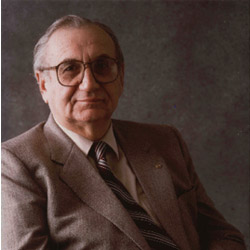BENJAMIN (BEN) NEWMAN FINK 1924-2009
 ALAN LONGSTAFF AND TOM FRICKE
ALAN LONGSTAFF AND TOM FRICKE
BEN Fink, who passed away aged 84 after a long illness, could safely be described as one of the founding fathers of the profession of consulting engineering in Australia.
Yet Ben came from relatively humble origins, born in Bialystok, Poland, and arriving with his family as a migrant from strife-torn Europe as a nine-year-old boy in 1933. He was the first in his family to learn to speak English on arrival and interpreted for his parents during regular family outings such as shopping.
Educated at University High School -— at that time one of only three state high schools in Victoria teaching to year 12 -— Ben graduated in civil engineering at The University of Melbourne and worked briefly with the MMBW (now Melbourne Water) and the CRB (now VicRoads).
In 1948, Ben joined the consulting engineering firm of Gutteridge Haskins & Davey (GHD) and remained with the firm until his retirement in 1990 -— a period of 42 years. Today, much of the growth of GHD as an international firm with more than 6000 staff derives from the foundations laid by Ben.
For more than four decades, Ben was active in Kew Hebrew Congregation: as trustee, as chairman of the committee of management, as chairman of the building committee, and as the organiser and honorary engineer for the progressive development of the synagogue, community hall and Mount Scopus Memorial College junior school.
GHD had scaled down its operations during World War II as many of its staff entered military service. Bernard Callinan (later Sir Bernard) -— himself a distinguished army officer and engineer -— recruited Ben to assist him in the challenge of rebuilding the southern operations of the firm.
Ben rose rapidly within the Melbourne office, becoming office manager in 1960 at the age of 35. He served as a GHD partner/director from 1965, was managing director from 1978 to 1986, and chairman from 1986 until his retirement in 1990.
During his long career with GHD, Ben was responsible for numerous innovations in water and wastewater engineering throughout Victoria and, via his role as consultant and adviser to numerous local authorities, the delivery of healthy water supplies and sewerage systems to many hundreds of thousands of Victorians -— spanning some 45 cities and towns.
His innovations extended to inverted syphons, prestressed concrete bridge design, wet-well pumping stations using submersible pumps, lagoon treatment plants and numerous construction advancements to achieve affordable cost-effective infrastructure delivery.
Engineers are traditionally a very conservative group, often content to adopt the practices of those who went before them, including an acceptance of the limitations imposed by scarce resources. But from graduation, Ben was determined to create, by his own example, a major technical and ethical change in engineering attitudes: firstly towards building infrastructure for rapidly expanding postwar urban communities and country centres in urgent need of these services, and then later towards innovative engineering practice as a whole.
In addition to major contributions to the health and amenity of many Australian communities through development of low-cost water and wastewater technologies, and new bridge and tower construction techniques, he also rationalised and optimised numerous industrial building projects — especially in the food industry.
His credo, throughout his professional career, and imbued in the many engineers he trained and mentored, was: “We must utilise all aspects of our theoretical training, backed up by our own initiative, research and progressive experience, to provide infrastructure of higher quality and constructability with much lower operating costs but at greatly reduced capital requirement.
Our objective is the use of our skills to provide the greatest number of outer-urban and country homes with best practical quality infrastructure available within the constraints of sector funding.”
Ben was an ardent proponent of the maximum use of Australian-trained engineers to solve our infrastructure challenges and needs. He initiated Australian engineering participation in the reconstruction of Melbourne’s West Gate Bridge when GHD was called in to assist in 1970. The pioneering MCG Floodlighting Towers were also ¬≠completed in 1985 during Ben’s time in Melbourne.
During some 30 years that Ben managed the Victorian GHD practice, he was mentor by example and guidance, to the many young engineers who joined GHD over that period. His influence on the way those engineers practised their profession and on influencing others, whether or not with GHD, has left a legacy of a very far-reaching and profound effect on the status of the profession of ­engineering.
Ben frequently espoused the virtues of private practice as crucial to the development of the independent professional engineer, and he was awarded the Consulting Engineers Advancement Society Medal in 1982, for his outstanding contribution to Australian engineering.
Ben is survived by Gertie -— his wife of more than 60 years -— his daughters Helen and Vivienne, two grandchildren and one great-grandchild.
His passing is a sad loss to the Jewish community and the Consulting Engineering profession.
Alan Longstaff and Tom Fricke both worked alongside Ben Fink for many decades at GHD.

comments